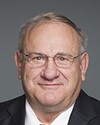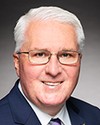Madam Speaker, I enjoyed hearing the previous speaker. It is always great to hear people, who have never taken any courses in the science of ecology, talking about the science of ecology. It showed.
I am very proud to rise in this House today to speak on Bill C-18, an act to amend the Rouge National Urban Park Act, the Parks Canada Agency Act, and the Canada National Parks Act.
Canadians recognize that it was the previous Conservative government that created Rouge National Urban Park by passing Bill C-40 on May 15, 2015. I was proud to be part of that government.
In the 2011 Speech from the Throne, our previous government also committed $143.7 million over 10 years to the creation of the Rouge National Urban Park. We understood the importance of this park and did not play politics with it.
However, the Ontario Liberal government thought it could play politics with the creation of this park. After Liberal provincial infrastructure minister Chiarelli secretly demanded a $100 billion payment for the land transfer, which was rejected on principle by our Conservative government, Liberal provincial minister Duguid wrote a letter as political cover, stating that the Ontario government would not transfer lands until the Rouge National Urban Park Act was amended to ensure that the first priority of park management was ecological integrity.
If we go back to what our act said, in that section, we see it said:
The Minister must, in the management of the Park, take into consideration the protection of its natural ecosystems and cultural landscapes and the maintenance of its native wildlife and of the health of those ecosystems.
That pretty much covers it all. Clearly, this ecological integrity ploy by the Ontario government was nothing but a ploy.
We now see, of course, that the federal Liberals are thanking their provincial cousins for their political assistance and are moving forward with the ecological integrity designation. It is important to note that the former CEO of Parks Canada, Alan Latourelle, disagreed very strongly with the ecological integrity designation, as it was an unrealistic approach to an urban park, which it is.
Mr. Latourelle was the CEO when Rouge National Urban Park was created. He says:
....all lands to be included in the Rouge National Urban Park Act will legally preclude all of the inappropriate uses—
He is referring to Ontario parks.
—mentioned above and will ensure that the vision of linking Lake Ontario to the Oak Ridges Moraine becomes a reality....
Any organization that implies that the Rouge National Urban Park Act does not meet current provincial legislation is misleading the public. There is simply no act that has been passed by the Ontario legislature that places ecological integrity as the first priority on Rouge lands owned by Ontario.
He went on to note:
In developing its management and legislative approach for Rouge National Urban Park, Parks Canada was guided by the IUCN’s Urban Protected Areas: Profiles and best practice guidelines. It is important to underline the fact that Rouge National Urban Park very clearly meets or exceeds all 30 of the IUCN’s urban protected area guidelines. In fact, based on the Agency’s review, the Rouge National Urban Park Act is the strongest legislation governing IUCN urban parks in the world.
It is clear that the way our government had set the park up was world class.
I will be supporting the legislation in principle, but it will need to be amended at committee for that support to continue. Let me explain why.
It is my strong belief that our national parks are about people. They are for people. They are about allowing people to have access to and explore nature. As well, national parks protect certain ecosystems and the biological, chemical, hydrological, and physical processes that are required by healthy ecosystems.
At the time of the park's creation, our government determined that the integrated approach was the most appropriate for the Rouge Park. There were three very clear interconnected priorities when it comes to protection: nature, culture, and agriculture.
This model is what Canadians and the Rouge Park Alliance, the former provincially appointed managing authority of Rouge Park, had asked for. This would allow the Rouge's natural, cultural, and agricultural resources to receive the highest level of protection now and far into the future.
Ecological integrity as the first priority of park management could be an opening to the interference with or even the removal of farmers from the park, which would be a real travesty.
The purpose of the Rouge Park, at least when we created it, is not to force farmers off the land, but these amendments could have that effect. Furthermore, the term “ecological integrity” implies a “leave it alone” approach to park management.
The leave it alone approach to managing lands is usually advocated by people who do not spend any time in nature. Farmers, ranchers, trappers or hunters know there is no such thing as leaving nature alone.
I will again go back to the previous act, which states, “The Minister must...take into consideration the protection of its natural ecosystems and cultural landscapes and the maintenance of its native wildlife and of the health of those ecosystems.”
It is important to also recognize the need to manage nature to achieve desired outcomes and to protect cultural landscapes. This is in direct opposition to the leave it alone approach advocated by many activists, most of whom have spent no time in nature at all.
Cultural landscapes in the Rouge National Urban Park refer to the agricultural operations that are currently operating within the park. Furthermore, there is no such thing as a static environment. Nature is changing all the time. There are droughts, floods, fires, invading species, plant successions, and so on. There are times when humans must “step in and actively manage nature”.
Back home in western Manitoba, we have been enduring years of high rainfall and floods. The ecosystem has changed dramatically, as have the wildlife species. Therefore, we are building drains and trying to manage water. Again, there are times when human beings must step in to manage nature.
A few years ago I purchased whose title intrigued me, and I have referred to it a number of times. It is called The God Species and is authored by environmental Mark Lynas. It is about how the planet can survive the age of humans.
Lynas states that human beings have become such a planetary force that we must step in when things are going wrong, and we have an obligation to step in to manage lands to deliver ecosystem health.
He says:
[Working] at a planetary level is essential if creation is not to be irreparably damaged or even destroyed by humans unwittingly deploying our new-found powers in disastrous ways. At this late stage, false humility is a more urgent danger than hubris....we must help it regain the stability it needs to function as a self-regulating, highly dynamic and complex system.
He goes on to note:
Most importantly, environmentalists need to remind themselves that humans are not all bad. We evolved within this living biosphere, and we have as much right to be here as any other species.... The Age of Humans does not have to be an era of hardship and misery for other species; we can nurture and protect as well as dominate and conquer. But in any case, the first responsibility of a conquering army is always to govern.
As a person who owns a farm and spends a lot of time in nature, what Lynas is talking about is stewardship. Stewardship is a very good, benign, and positive word when it comes to what human beings do with the environment.
The idea of pristine nature is largely a myth. William Denevan, from the University of Wisconsin, wrote a paper called, “The Pristine Myth: The Landscape of the Americas in 1492”. In it he noted this with respect to the Latin American forest:
Large expanses of Latin American forests are humanized forests in which the kinds, numbers, and distributions of useful species are managed by human populations.
Aboriginal people lit prairie fires on a regular basis to keep the woody species down and ensure lots of grass for the bison herds that they depended on. One of the management strategies for wetlands is to draw wetlands down periodically and allow the soil to dry out and improve the health of wetlands.
On my farm, because I liked having wildlife around, I have created openings in the forests, and I am able to improve wildlife populations.
The recreational fisheries community, working with fishery biologists, create new fish spawning areas. The Miramichi Salmon Association, through our recreational fisheries conservation program, creates cold water refugia for Atlantic salmon so they can survive warm water temperatures. Therefore, active management of landscapes and the environment is more common than not.
Europe, for example, is one completely managed landscape, designed to deliver certain ecosystem services to people, from agriculture to forestry to wildlife. Therefore, rural Europe is one big managed garden.
Again, only in North America can we have this peculiar conceit about pristine landscapes. We are the only place in the world that talks this way. The rest of the world has to actively manage landscapes to deliver certain ecological outcomes. However, we are actually getting pretty good at this now, although it has taken many years. Our knowledge is growing all the time and we are making better decisions all the time.
Getting back to Rouge National Urban Park, it is a highly impacted park. It is surrounded by development. The term “ecological integrity” very much implies a leave it alone and hope things work out approach. We will have invasive species in there. We will perhaps have the hydrological cycle disrupted because of the way the highway patterns are. A whole bunch of things are going to happen in there. Will the government do anything about it? The traditional Parks Canada approach is to leave it alone.
Interestingly enough, there are many instances where human beings have touched the earth very lightly and created conditions that are better ecologically than otherwise would have been. Let us take Grasslands National Park in Saskatchewan, for example. I have had the honour of visiting it a few times.
Grasslands National Park was created by ranchers. If it were not for the ranchers grazing, and the way they grazed, that national park would not have the attributes it has now, and it would not have had the attributes that would have made it a desirable place to create one of Canada's most unique and important national parks, which creates unique, rare, and important plant and animal communities. It is all because of what the ranchers did.
Parks Canada's initial view when the park was being created was that the ranchers had to go. However, it quickly realized that it was grazing that kept the park's ecosystem intact. I check recently and cattle ranching has continued to be part of the management of Grasslands National Park.
As I said earlier, I have the honour of owning a farm, 480 acres, with 320 acres under a permanent conservation easement with the nature conservancy. Therefore, I have my own mini-Rouge Park with a bit of agriculture in it, forest, wetlands, and wildlife. From personal experience, there are ways to touch the land very lightly and deliver the things people want.
My riding also happens to encompass Riding Mountain National Park. I live very close to that park. In fact, it is one of the reasons I moved there.
Although Riding Mountain National Park is a rural park, it has some characteristics similar to Rouge National Urban Park. It is about 1,000 square kilometres, or maybe bigger, but it is a large park surrounded by a sea of agriculture. The park is very important, and it is one of the few aspen parks. It protects the very rare rough fescue prairie. The bird diversity is extremely rich in summer. There are high populations of elk, moose, deer, plus wolves and black bears. It is an absolutely wonderful place.
It started off as a Dominion forest reserve in the late 1800s as a source of wood for the settlers, and then it became a park. Forestry was allowed up until I think the 1960s and early 1970s, and then was eliminated, just like that. The people who cut wood on a sustainable basis were told to leave. As a result of that, the forest kept getting older and older. Keep in mind, there is no fire suppression in Riding Mountain National Park. Therefore, is this a natural ecosystem?
In the name of ecological integrity, grazing was eliminated in the park. There were a number of ranchers who were allowed to graze their cattle in the park, but I think it was in the mid-1970s that they were all summarily told to leave, at great cost to individual farmers, and with no compensation whatsoever.
In the 1970s, the Liberal government kicked the farmers out of the Riding Mountain National Park, with no compensation. There was some great cost to wildlife as well. What haying and grazing did in that park was maintain the grasslands. Elk especially are a grassland species, so elk populations suffered because of this.
Adapting ecological integrity in the Rouge could see many Rouge farmers evicted from working farms that have been in production since as early as 1799.
If the Liberals say that they support both farming and ecological integrity, as it is legally defined by the Canada National Parks Act, they are at best naive, or misinformed or, at worst, misleading the farming community. These farmers, who have been responsible stewards of the economy for generations, must be allowed to remain in the park.
Interestingly, wildlife is always an attribute in national parks. People like seeing deer, for example, apart from the fact that they run in front of our cars. The point is that high deer populations are, by and large, well liked. People very much enjoy seeing Canada geese and waterfowl flying around.
What the farming in Rouge Park does, especially if the farmers are growing corn, soybeans and grains, is provide very important food for wildlife species. Some might say it is just artificial. It is not, because farming is part of the ecosystem of that park.
What Rouge Park has the potential to be a very diverse and wonderful place where ecological services and cultural amenities are conserved and protected.
During the committee hearings on Bill C-40 in the previous Parliament, we heard from Mr. Larry Noonan from the Altona Forest Community Stewardship Committee. He said:
Some people have asked why the term ecological integrity is not in the act. The Canada National Parks Act states that “ecological integrity” includes “supporting processes”. As a further clarification of part of this definition, Parks Canada defines “ecosystem processes” as “the engines that make ecosystems work; e.g. fire, flooding...
It is very important. Ecological integrity talks about letting it all happen, fires and floods.
It is clear, as Mr. Noonan continued that “Ecological integrity cannot be applied to an urban national park”. He was very clear, and he has the moral authority to stand by these words. Furthermore, he stated:
We cannot allow fires and flooding in the Toronto, Markham, and Pickering urban environment. The Rouge national urban park act cannot have this term included, or there would have to be a list of exceptions to the definition which could serve to lessen its impact in the Canada National Parks Act.
Only two of the 11 committee witnesses supported or espoused ecological integrity during the previous Parliament. Eighty-one per cent of the witnesses present did not ask for ecological integrity to be included, yet the Liberals chose to use it in the legislation before us.
The true definition of “ecological integrity” would imply letting forest fires burn, floods to run their course and wildlife to survive without human intervention. A number of species of wildlife are problematic, such as raccoons and skunks that carry rabies. Will this park be a reservoir for those species? Perhaps it is now.
The Rouge sits alongside residential neighbourhoods, has highways, power lines, a pipeline across various parts of it, working farmland, a former landfill dump site and an old auto wreckers yard. For these reasons, any attempt at calling our actions “ecological integrity” would be in words only.
Ecological integrity, as the primary guiding principle for the park, is an unrealistic measure for an urban park that was established to introduce Canadians to nature, local culture and agricultural, the first of its kind in Canada.
In real terms, if the government were to apply the concept of ecological integrity to the Rouge National Urban Park the consequences on local communities and municipalities could be dire. The creation of Rouge National Urban Park was a great accomplishment for which I am very proud of our former Conservative government. I would urge the Liberals to reconsider their adamant and unwarranted support for the inclusion of ecological integrity as the first priority of park management.













